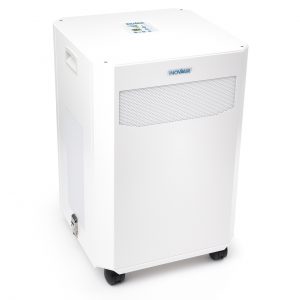Bushfires are a very real issue facing residents around the world.
The irreparable damage caused by bushfires can be very traumatic. But there’s a less spoken hidden health hazard related to fires: Smoke.
Over the last few days the conditions have been ideal for bush regeneration, causing a pall of smoke and haze to hang over areas in Sydney. This smoke has the added issue of a lack of visibility. Drivers in particular need to take care when driving in such conditions.
Usually, Sydney’s air quality is considered good to very good, according to the NSW Office of Environment and Heritage, which has an air quality data index which is updated every hour. Check the site for more information about your current air quality.
Bush fires can result in a large amount of smoke particles and pollens which are easily transported throughout the state by wind. Increased particulate matter in the air irritate airways and have been shown to have adverse health effects on cardio-respiratory health.
The particles are measured at Particulate Matter PM10 and PM2.5. The larger particles with a diameter less than 10 micrometres are usually trapped in the nose and throat and swallowed. The smaller particles with a diameter less than 2.5 micrometres, often referred to as ‘fine particles’ are unpleasant, unhealthy and have nowhere else to go except your lungs and cause irritation.
Smoke Hazards
Bushfire smoke is a mixture of different-sized particles, water vapour and gases, including carbon monoxide, carbon dioxide and nitrogen oxides according to Queensland Government When you can no longer clearly see a landmark this means air quality has deteriorated advises Environment Protection Agency. Estimate the visible distance, by observation of the nearest landmark that is just obscured by the smoke. Health category ‘unhealthy – sensitive’ has cautionary health advice that suggests practical ways you can reduce your exposure to PM2.5 in smoke visibility down to 5 to 10 kilometres and ‘unhealthy – all’ visibility down to 2 to 5 klm.
Symptoms Related to Smoke Irritation
Smoke irritation is of particular concern to those with existing illnesses such as asthma, bronchitis, hay fever, allergies and lung conditions as these can be further aggravated according to EPA Victoria (2017).
- acute itchy or burning eyes and throat,
- runny nose,
- coughing or shortness of breath,
- headaches.
Children, the elderly and those with respiratory conditions are most vulnerable and need to take extra precautions. People who are otherwise healthy can be adversely affected by high bush fire pollution levels as well and are encouraged to avoid running or exercising outside.
Advise by Authorities
Those inhabitants that are at risk from bush fire smoke should
- pay attention to media reports
- stay inside with doors and windows closed
- drink plenty of water
- try to stay cool
- don’t exercise outside
- asthma sufferers should follow their asthma action plan
- as well those with people heart or lung problems, make sure you always have at least 5 days’ worth of medication with you.
Where possible, the best treatment is to avoid smoke polluted environments and find cleaner air. Air conditioned rooms provide welcome relief, whether at home or in a friend’s place, in the shopping centres, library, art gallery, restaurant, movie theatre according to Department of Health Western Australia.
Consider Hiring an Air Purifier
Breathe easier, sleep soundly and feel better by improving your indoor air quality
PRODUCT:
Air Purifier
E20 PLUS includes an additional final stage 6kg carbon filter for applications requiring heavy duty chemical & odour removal. Excellent for removing pollution from main roads, smoke and mycotoxins produced by mould spores.

Towards healthier living Carol Parr ♥
As Building Biologists, we have acquired knowledge of adverse health effects and recommend effective strategies to reduce occupants’ exposure by eliminating and controlling as many sources of pollutants in order to create healthy indoor living environments that are as exposure-free and natural as practically possible.
References:
Environment Protection Agency Victoria. 2017. Effects of Smoke. [ONLINE] Available at: https://www.epa.vic.gov.au/your-environment/air/smoke/effects-of-smoke. [Accessed 30 November 2018].
Queensland Government. 2018. Bushfire Smoke and Your Health. [ONLINE] Available at: https://www.qld.gov.au/health/staying-healthy/environmental/after-a-disaster/bushfires/bushfire-smoke-and-your-health. [Accessed 30 November 2018].
Queensland Government. nd. Smoke Hazards from Bushfires. [ONLINE] Available at: https://healthywa.wa.gov.au/Articles/S_T/Smoke-hazard-from-bushfires. [Accessed 30 November 2018].
Author
-
We’re glad you’re here. We’re Carol and Tony, founders of one of the longest running Healthy Home Blogs in the world, Mitey Fresh Australia. We’ve been on this journey for the last 25 years and are passionate about helping families sift through health hazards and triggers like allergens, mould, water damage, chemicals and EMFs, to get clarity about what’s toxic and what’s not so they can create a healthy and happy home for their family they love. Each month, people visit this blog seeking focus on the health and wellbeing of their loved ones, sustainable and effective practice tips and guides, to help create and manage healthier indoor spaces, improve the built environment that is pleasing to the senses and support healthy living and nature, every day. Starting this blog was to help change people’s lives, one family at a time, and we can’t wait to share how its allowed us to stand next to you and show you how interpreting these synergies between buildings and the environment they are built in will impact upon the health and well-being of those who occupy them. Find out more about Healthy Homes and what this blog can do for you!





